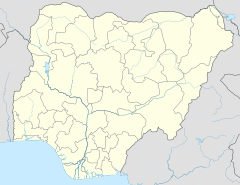Ancient Kano City Walls
| Ancient Kano City Walls | |
|---|---|
 Sabuwar Kofa, one of the city gates | |
| Type | Defensive wall |
| Location | Kano Nigeria |
| Coordinates | 11°57′20″N 8°29′51″E / 11.9555°N 8.49754°E / 11.9555; 8.49754 |
| Height | 50 feet (15 m) |
| Built | 1095–1134 |
| Built for | Defence |
| Governing body | Kano State Tourism |
The Ancient Kano City Walls (Hausa: Ganuwa) were ancient defensive walls built to protect the inhabitants of the ancient city of Kano.[1] The wall was initially built from 1095 through 1134 and completed in the middle of the 14th century. The Ancient Kano City Walls were described as "the most impressive monument in West Africa".[2]
History
The Ancient Kano City Walls were built as a defensive wall with the construction of the foundation laid by Sarki Gijimasu (r. 1095–1134), the third king of the Kingdom of Kano in the Kano Chronicle.[3] In the mid 14th century during the reign of Zamnagawa, the wall was completed before it was further expanded during the 16th century.[4] According to historians, the then General-Governor of the Colony and Protectorate of Nigeria, Fredrick Lugard, wrote in a 1903 report about the Kano Walls that he had “never seen anything like it in Africa” after capturing the ancient city of Kano along with British forces.[5]
Structure

The Ancient Kano City Walls are made up of Dala Hill where it was founded, Kurmi Market and the Emir’s Palace.[6]
The Ancient Kano City Walls originally had an estimated height of 30 to 50 ft and about 40 ft thick at the base with 15 gates around it.[6]
See also
Further reading
- Nigeria. National Commission for Museums and Monuments (2003). Perspectives on Kano-British relations. Gidan Makama Museum. ISBN 978-978-36886-0-5.
- Toyin Falola (2009). Colonialism and violence in Nigeria. Indiana University Press. ISBN 978-0-253-35356-6.
- Rasheed Olaniyi (2008). Diaspora is Not Like Home: A Social and Economic History of Yoruba in Kano, 1912-1999. LINCOM EUROPA. ISBN 978-3-89586-110-9.
- Bawuro M. Barkindo (1989). Kano and Some of Her Neighbours. Department of History, Bayero University, Kano. ISBN 978-978-125-059-0.
- Moody, H.L.B. (1969). The Walls and Gates of Kano City. Department of Antiquities. Federal Republic of Nigeria.
References
- ^ "Kano tourist attractions make national monument list". Vanguard. 30 January 2015. Retrieved 18 August 2015.
- ^ "Ancient Kano CIty Walls and Associated Sites". World Heritage Sites. Retrieved 18 August 2015.
- ^ Ki-Zerbo, Joseph (1998). UNESCO General History of Africa, Vol. IV, Abridged Edition: Africa from the Twelfth to the Sixteenth Century. University of California Press. p. 107. ISBN 0-520-06699-5.
- ^ "Salvaging Kano City's crumbling Walls". The Nation. 11 February 2014. Retrieved 18 August 2015.
- ^ Bawuro M. Barkindo (1989). Kano and Some of Her Neighbours. Department of History, Bayero University, Kano. ISBN 978-978-125-059-0.
- ^ a b Attahiru Muazu Gusau. "The Demolition Of Kofar Na Isa And The Challenge Of Re Constructing". Gamji. Archived from the original on 24 September 2015. Retrieved 18 August 2015.
